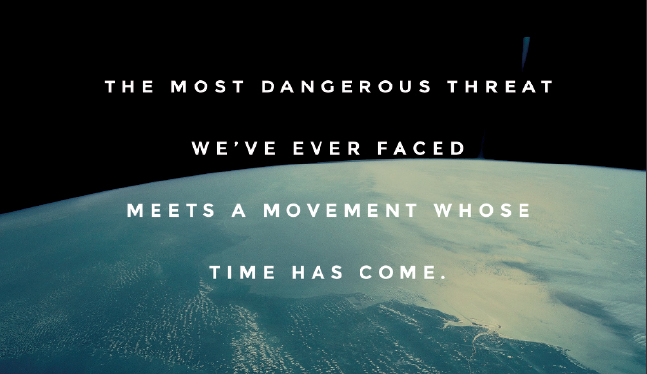On September 21st in New York City, individuals and groups from across American society will be coming together to march, to make a collective statement that the climate crisis cannot be ignored any longer. The People’s Climate March aims to be the largest climate demonstration in history, and it comes at a pivotal time — the weekend before President Obama visits New York City for the UN Climate Summit, and a year before the Paris COP 21 negotiations, which are regarded by some as the remaining diplomatic opportunity for a treaty that can hold emissions to the 2°C target. The 2°C target is hoped to keep us within range of a world we recognize.
Breaking just ahead of the march will be public screenings of a film called Disruption, and it’s goal is also ambitious.
On September 7th, the producers of the film will distribute the 52 minute documentary online at screenings held around the country, from college campuses to living rooms. The film’s website provides information on how to find a screening, or set up your own.
Taking a cue from the sudden organization of flash mobs, Disruption aims to make people stop what they are doing, watch, and come together as a collective community to begin change. The project emphasizes the importance the September march will have in attracting the attention of global leaders, who must respond to the environmental tipping points on which we are so delicately balanced.
Helmed by the producing and directing team of Kelly Nyks and Jared P. Scott, the documentary takes a long hard look at the consequences of sitting on our hands when dealing with climate change. The viewer is at a critical moment in human history; we are the first generation to experience climate change, and we are the ones who must work towards a better and cleaner future.
For the Disruption team, mobilization starts with the idea that issues of climate change, and by immediate extension, the Climate March, are not simply matters thrust into the hands of your local environmentalists. Scott told us: “what makes Disruption different is that it’s about reframing the issue, not as an issue that revolves around the environment, but as an issue that touches on almost every area that is of importance to us as a global community.” In other words, having global temperatures increase by or go beyond 2 degrees can have a disastrous impact on issues like social justice, equality – even work, as jobs disappear as climate change takes a toll on the economy.
[pullquote align=”right”]”We see it as an action film…”[/pullquote]Disruption cites these issues as the reason for urgency, and while scientific facts are presented, the filmmakers stress that the emphasis is on climate change being recognized as a globally visible and immediate crisis that lives beyond data. “The narrative as repeated by journalism and film is generally framed as a problem for our children and our grandchildren, and the problem of tomorrow, or after tomorrow. But the changes we see taking place [show] that those tomorrows are very much happening today.”
The filmmakers note the measurement taken last May revealing atmospheric CO2 concentration passed 400 parts per million. The long-term safe concentration is considered to be 350 ppm. Passing beyond this point will not just make the Earth warmer, but also has the potential to wreak havoc on the global economic system. Job losses are already among the impacts of Hurricane Sandy, for example, which caused a cut of approximately 86,000 jobs from the payroll.
It’s this wide reach that Disruption takes into account. “For us, the challenge and opportunity was to tell a story that didn’t look at climate through a narrow lens, but as a social issue. We see it as an action film, seeing this movement build to rise up to fight the greatest crisis that mankind has ever faced.”
Disruption attempts to bring the issue home to as many people as possible. By allowing groups and everyday people around the country to host screenings, the filmmakers created the basis for a broad, grassroots media campaign to rally support for the Climate March and to present climate change to viewers who aren’t necessarily engaged with environmental issues. “It’s a really contemporary approach to filmmaking; we use our films as a tool for social action…This film is a central tool for a lot of different people. Faith groups are probably using it differently than college groups would.”
In doing this collective screening, Nyks and Scott hope to recreate the atmosphere of the march to “capture a similar energy that one would find there. There is a collected effervescence in knowing that it is simulcast. This film is going to allow people to realize it’s important to go and see the people who are involved in the movement.”
